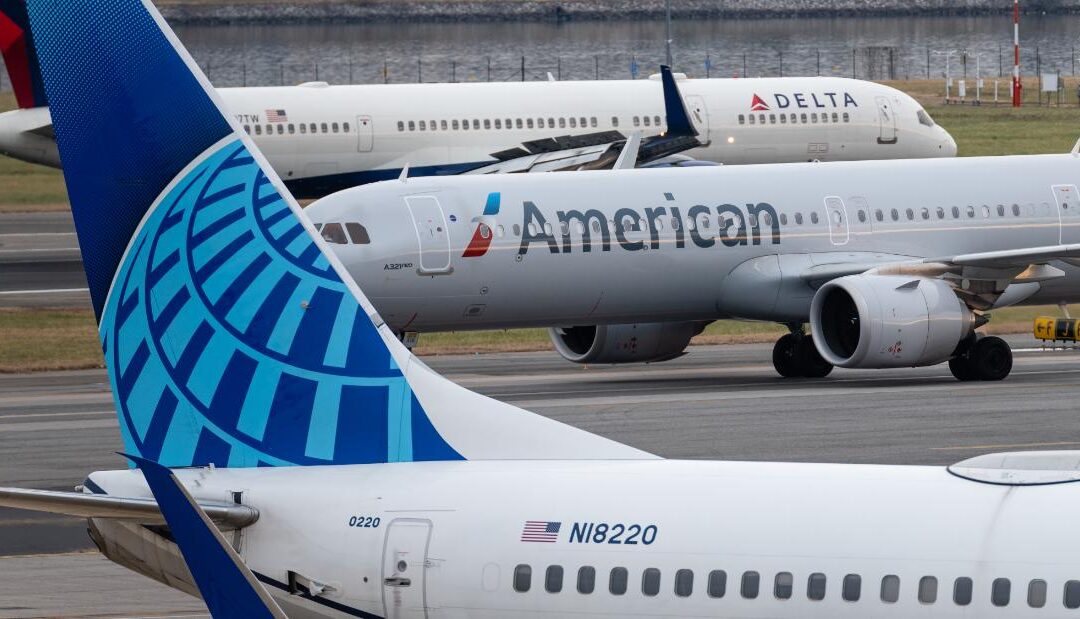(CNN) — As pandemic-related restrictions begin to raise, and we emerge from the lockdown shadows, one factor is returning to the minds and spending of many individuals: journey.
In fact, we all know the reply: cease touring. Or, at the least, cease flying.
However whereas the flight disgrace motion is rising, it isn’t for everybody. And simply since you aren’t ready to make that sacrifice, doesn’t suggest you possibly can’t make smaller adjustments to make sure your journey is extra sustainable.
What is the massive deal about flying?

The aviation trade is rising at an unsustainable price for the atmosphere.
Stefani Reynolds/AFP/Getty Photographs
“It’s important to take a look at the expansion of the sector. It is fairly important, regardless of Covid,” Mirolo stated. “Even after 9/11 or the Nineteen Seventies oil disaster, aviation grows again stronger. Now it is rising once more, and it is a largely unregulated sector.”
“If we do not do something now, in a number of years aviation will likely be one of the vital important contributing elements. We should not take a look at the snapshot now,” he stated, “we should always take a look at the forecast.”
Excellent news and dangerous

The issue is, so many people need to fly.
Evert Elzinga/EPA/Shutterstock
The excellent news? “Numerous options” are within the pipeline, Mirolo stated.
The dangerous? They are not prepared but. Anticipate actual ends in “many years.”
Neste, a biofuels firm which sells SAF to the likes of American Airways, KLM, Lufthansa and Delta, makes use of palm oil in its non-SAF biofuels, although an organization spokesperson says that it’s sustainably sourced and will likely be phased out by the top of 2023. Utilizing palm oil as gas stated Mirolo, is “a treatment worse than the illness.”
That is all unconfirmed, as but. The one SAF mandates presently in place are Norway, Sweden and France, every of which oblige carriers leaving the nation to make use of 1% SAF.
In the meantime, we’re taking a look at round 2030-35 for the introduction of hydrogen-powered planes, if we’re being optimistic, stated Mirolo. Even once they’re launched, they’re going to solely be able to flying below 2,000 miles — that means they will not be viable for long-haul flights.
As for battery-powered planes, once more, 2030 could be optimistic, stated Mirolo, and they’re likewise unsuitable for lengthy journeys. An hour’s flight is presently the restrict for a 100-seater aircraft. Plus, he stated, we’ll must work out the local weather affect of constructing and altering batteries — they is probably not as nice as we predict. Hydrogen and electrical planes may cowl round 20% of the projected passenger demand by 2050, he says — which is why he thinks SAF is a greater wager.
Mirolo stated that airways that trumpet their carbon offsetting schemes are ones to keep away from. “Carbon offsetting was in vogue a number of years in the past however we all know it isn’t the answer — the answer is SAF,” he stated.
Backside line: Fly much less

Strive returning to seeing flying as a deal with, reasonably than your go-to.
iStockphoto/Getty Photographs
Consultants are sensible and acknowledge that most individuals will really feel the necessity to fly someday. As Childs put it: “None of us are angels.”
Francis believes journey broadens minds and helps native communities, however says many are doing an excessive amount of of it. As a substitute of leaping on each low cost flight we get an alert for, Francis suggests we roll again to a time when getting on a aircraft was a deal with.
We have to get out of the mindset that we have to fly a lot, these specialists say. Childs stated that boarding a aircraft must be our final choice. “The most effective factor to do is rail, or, mile for mile, even driving goes to be higher,” he stated.
Mirolo stated that every time we plan a visit, we should always “assume twice about flying.” Are you able to go by one other technique of transport? If it is a enterprise journey, is an in-person assembly important or are you able to do it remotely? “It’s important to resolve whether or not you are going to take that aircraft. It is not about stopping flying altogether, however being affordable.”
“Our place is to encourage individuals to take longer holidays, which can imply fewer flights complete,” stated Francis. “An extended journey is extra stress-free and fulfilling, and carbon does must be prime of our minds. We have to select massive journeys extra consciously and use different types of transport to journey nearer to residence.
“For me, as a substitute of two long-haul flights a yr I’d nonetheless go to Vietnam, however for one in all my longer journeys I’d do a gradual journey prepare journey to Italy.”
Trains and buses

Touring on the floor of the Earth will at all times be higher than flying.
Amtrak
In fact, it helps that Francis is predicated in Europe, the place high-speed prepare journey is the norm. However even if you happen to’re someplace with restricted public transportation, just like the US, it is nonetheless higher to keep away from flying, stated Childs.
He reckons {that a} lengthy cross-country US highway journey, say, from Washington, DC to Yellowstone Nationwide Park, will likely be much less dangerous to the atmosphere than a fast flight to the Caribbean.
“In the event you’ve no choice to go by prepare or public transport, and you have a selection between driving and flying someplace, then driving will at all times be the higher choice,” he stated. “It is simpler to shift a physique in an enormous lump of steel by highway than by sending it up into the air and retaining it there… Someday there might be greener types of flying a brief distance, however proper now go on the floor the place you possibly can.”
And the extra typically that floor transport is public (i.e. trains, buses) the higher.
Find out how to fly

Final yr Airbus revealed a trio of hydrogen-powered zero-emission airliner ideas, below the banner ZEROe, which may enter service by 2035.
Airbus
For these of us who’ve been fortunate sufficient to fly enterprise class, going again to financial system is tough. However financial system is the greenest technique to fly — and funds airways that cram as many seats in as doable are probably the most environment friendly planes within the sky.
Premium seats made up simply 5% of worldwide site visitors in February 2022, in accordance with the Worldwide Air Transport Affiliation, but premium seats take up much more room on a aircraft. As an example, all-economy Wizz Air has 239 seats on its A321neo plane, whereas its European rival Lufthansa, which has a shorthaul enterprise class, operates the identical aircraft configured for simply 215 passengers. Each fly the A320-200, too — Lufthansa’s model has 168 seats, whereas Wizz’s crams in as much as 186 passengers.
On shorthaul routes the distinction between enterprise and financial system class is prone to be a wider seat and possibly a bit extra legroom, however long-haul configurations change the dynamics solely, with house for lie-flat beds and even whole “suites” on the likes of Emirates and Singapore Airways, every taking on the equal of a number of rows of financial system class.
Each Singapore Airways and Emirates fly the A380, for instance, however the former places financial system and premium financial system on the highest deck; the latter reserves it for enterprise and top notch. The distinction? Singapore Airways matches a complete of 399 passengers on its prime deck; and Emirates, simply 90, in the identical house.
Enterprise and top notch parts are usually a lot heavier as properly, with chairs sitting in fastened “shells,” and generally closable doorways for every seat.
Finances carriers are greener — on paper at the least

Wanting on the growth of funds airways, they’re much less inexperienced than you think about.
Jason Alden/Bloomberg/Getty Photographs
The European provider Wizz Air calls itself the “greenest” airline on the continent, due to its younger, fashionable fleet, pile-’em-high, all-economy seating philosophy, and its endeavor to solely fly direct. In addition they do not provide any routes for which there is a rail different in below 4 hours. Wizz claims the bottom CO2 emissions per passenger kilometer in Europe and tells passengers, “In the event you need not fly, please do not.”
Nonetheless, that is not the entire image, stated Mirolo. Low-cost carriers “are those rising very quick,” he defined — so whereas their metrics per passengers look good, they are a main a part of aviation’s problematic growth.
In relation to legacy carriers, he stated that long-haul flights are the difficulty — with 5% of flights representing 50% of emissions. The EU’s proposed SAF mandate applies solely to plane departing from EU airports — which signifies that whereas flights throughout the bloc could be coated, the mandate would solely apply to half of long-haul flights (these leaving the EU, however not coming in).
That is why Mirolo recommends involved passengers put their cash the place their mouth is, reserving flights with airways who’ve been investing in, and already utilizing, SAF in a “credible” manner. These embody United, Alaska, Qantas and SAS, which even permits passengers to purchase “blocks” of biofuel alongside their flights, and are rewarded with additional miles in the event that they achieve this.
Air France-KLM is sure by the 1% SAF mandate for flights leaving France, however since January has dedicated to 0.5% SAF in each aircraft departing their Amsterdam Schiphol hub, too. A surcharge (€1-€10) is utilized to tickets.
Mirolo additionally stated involved fliers must be utilizing their vote to make the aviation trade extra sustainable. “There’s unprecedented political will to make [sustainable aviation] occur, and actual motion, so vote along with your poll, after which vote along with your toes.”
Personal jets are ruinous — however may additionally assist

New tech is almost certainly to occur on smaller planes first — so the personal jet market may assist.
Eviation Plane
For many of us, the closest we’ll get to flying in a personal jet is watching celebrities’ social media posts. However simply because it is a technique of journey for the elite, doesn’t suggest it isn’t affecting all of us.
A 2021 examine by the environmental nonprofit Transport & Surroundings, discovered that 1% of individuals have been chargeable for half of all world emissions from flying. The personal jet trade is booming, increasing by 31% between 2005 and 2019. What’s extra, 40% of personal flights are “ghost flights” — empty of passengers as they reposition for his or her subsequent pick-up.
As a result of personal jets are inclined to make brief hops, that makes them even much less environmentally sustainable. The shorter the hop, the much less needed it’s, too. “For 80% of the preferred (personal jet) routes in Europe, there’s another by prepare,” stated Mirolo, including that in accordance with his tally, 10% of flights taken in France are actually personal.
The excellent news, nevertheless, is that, due to their smaller dimension, personal jets might be on the forefront to adapt to new expertise because it comes in the marketplace. That, in flip, may assist the market transfer ahead, sooner.
“The tremendous wealthy can tremendous cost the decarbonization of aviation by investing in these type of planes,” stated Mirolo, referring to electrical and hydrogen-fueled planes. And in the event that they try this, the 1% will assist the 99% fly extra sustainably.



Recent Comments